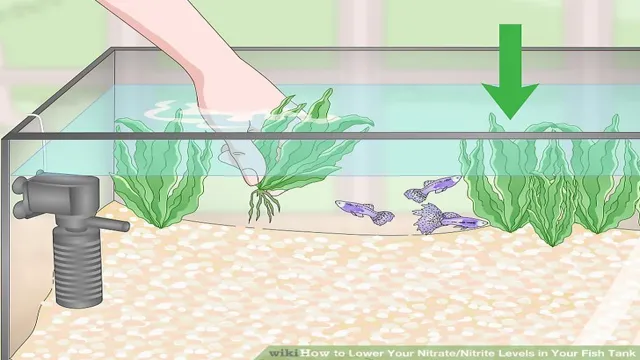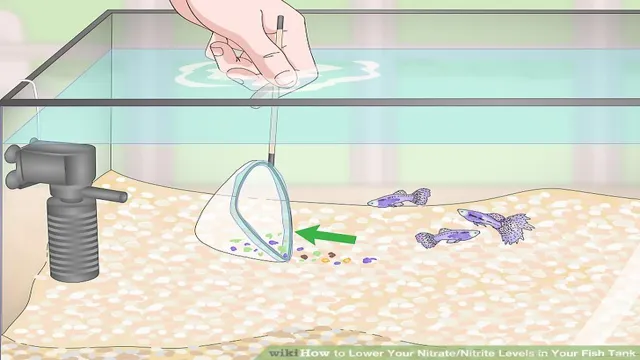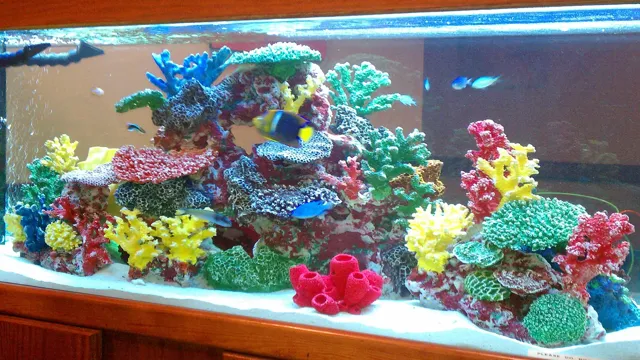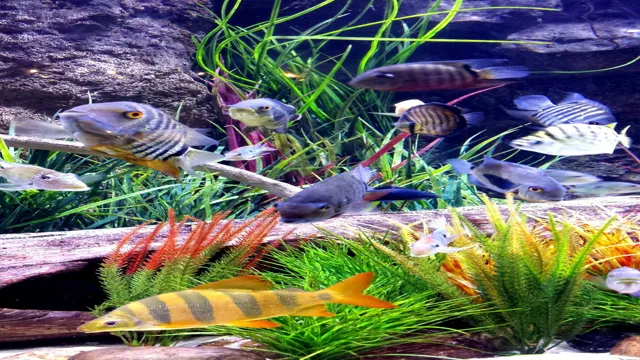Are you worried about the high levels of nitrite in your aquarium? Nitrite is a harmful substance that can build up quickly in fish tanks, leading to stress and sickness in your aquatic pets. It’s important to keep nitrite levels in check to ensure a healthy and happy environment for your fish. But don’t worry – lowering nitrite levels is easier than you might think! In this blog, we’ll explore some tips and tricks to help you decrease nitrite levels in your aquarium and keep your fish thriving.
So, dive in and let’s get started!
Understanding Nitrite in Your Aquarium
Nitrite is a harmful chemical compound that can be found in your aquarium. High nitrite levels can cause serious health problems for your fish, such as suffocation, inability to swim normally, and even death. Thus, it is important to keep your nitrite levels under control.
One way to reduce nitrite levels in your aquarium is by performing partial water changes regularly. This involves removing a portion of the old water and then replacing it with fresh, clean water. Another method is to use biological filtration that includes beneficial bacteria to convert nitrites into less harmful compounds.
Lastly, avoid overfeeding your fish as leftover food can produce excess nitrites in the water. By maintaining a clean tank and monitoring your nitrite levels regularly, you can ensure the health and happiness of your aquatic pets. Remember to test your water regularly and take necessary steps to keep nitrite levels down in your aquarium.
What are Nitrites?
Nitrites are a common aspect of an aquarium’s water chemistry, and understanding their role is crucial for your fish and other aquatic creatures’ health. Nitrites are produced by the breakdown of excess food, fish waste, and other organic matter in your aquarium. These compounds can be highly toxic to your fish, causing respiratory distress, damage to their gills, and ultimately death.
Moreover, nitrites can also affect the beneficial bacteria that help keep the water clean and healthy, creating a self-perpetuating problem. That’s why it’s important to regularly test your aquarium’s water for nitrites and take measures to keep them at safe levels. By doing so, you can ensure a healthy and flourishing aquatic environment for your pets to thrive.

Why are High Nitrite Levels Dangerous for Your Fish?
Nitrite is an essential component in the nitrogen cycle of an aquarium. It is produced when biological waste breaks down into ammonia and then further decomposes into nitrite through the process of nitrification. While nitrite is a necessary element in maintaining a healthy aquarium, high levels of nitrite can be dangerous for your fish.
Nitrite poisoning can cause numerous health problems and even death in fish. Symptoms of nitrite poisoning include labored breathing, erratic swimming behavior, and loss of appetite. It is crucial to understand the nitrogen cycle and to monitor nitrite levels in your aquarium regularly.
Utilizing a good filtration system, avoiding overfeeding, and performing regular water changes are effective ways to maintain healthy nitrite levels in your aquarium. Ensuring proper nitrite levels will help keep your fish healthy and thriving.
How to Test for Nitrite Levels in Your Aquarium
Nitrite Nitrite is a chemical compound commonly found in aquariums as a result of waste products like fish food, fish poop, and dead plant matter. It is a harmful substance that can cause serious health problems for the fish in your aquarium if not properly controlled. Nitrite is produced by bacteria that break down the organic waste in the water and is usually present in small amounts.
However, if there is an overgrowth of certain bacteria or if the tank is not properly maintained, nitrite levels can become too high. Testing for nitrite in your aquarium is essential to ensure that the levels are within safe limits for your fish. Nitrite test kits are readily available and easy to use, providing accurate readings to help you maintain a healthy aquatic environment for your beloved aquatic pets. (See Also: How to Build a Freshwater Aquarium Sump: A Step-by-Step Guide for Beginners)
Identifying the Cause of High Nitrite Levels
If you have noticed high nitrite levels in your aquarium, it is important to identify the cause and take action to bring them back down to safe levels. Nitrite is toxic to fish and can cause health problems or even death if left unchecked. One possible cause of high nitrite levels is overfeeding your fish, as excess food can break down and release nitrogenous waste into the water.
Another cause can be inadequate filtration or a lack of water changes, allowing waste to build up. Testing your water regularly can help you catch high nitrite levels before they become a problem. In order to lower nitrite levels, you can perform partial water changes, increase the frequency of water changes, and adjust your feeding habits.
Incorporating plants into the aquarium can also help by naturally filtering the water. It is important to monitor and maintain water quality in your aquarium to ensure the health and wellbeing of your fish.
Overfeeding Your Fish
Overfeeding Your Fish High levels of nitrite in your fish tank could signal an overfeeding problem. If you’re overfeeding your fish, the excess food produces more waste than your aquarium’s ecosystem can handle. This, in turn, leads to high nitrate and ammonia levels, which can be toxic for aquatic life.
The key to correcting this problem is to avoid overfeeding your fish. A good rule of thumb is to feed them small amounts of food two to three times a day. Anything more than that could lead to nitrite buildup.
You can also consider using a fish feeder or measuring the exact amount of food they require. Additionally, it’s important to perform regular water changes and use a water test kit to monitor nitrite levels. By taking these steps, you can identify the cause of high nitrite levels and ensure a healthy and thriving aquarium ecosystem for your aquatic pets.
Overstocking Your Aquarium
If you’re an aquarium enthusiast, it can be tempting to add more fish than your tank can handle. Unfortunately, overstocking your aquarium can cause high levels of nitrites, which can be deadly for your aquatic friends. Identifying the cause of high nitrite levels can save your fish from potential harm.
Nitrites can be produced through the breakdown of organic matter in the water, such as uneaten food, fish waste, and decaying plants. An overcrowded aquarium means more organic matter, which can lead to unhealthy nitrite levels. To avoid this, make sure to only add fish that are appropriate for the size of your tank and properly maintain the tank by regularly removing any uneaten food and debris.
By keeping your aquarium balanced, you can ensure the health and longevity of your water-dwelling pets.
Lack of Proper Filtration
If you’re experiencing high nitrite levels in your aquarium, a lack of proper filtration could be the cause. Nitrite is toxic to fish and can lead to illness or death if levels are too high. One of the primary functions of filtration is to remove harmful substances like ammonia and nitrite from the water.
If your filtration system is not properly removing these substances, nitrite levels can quickly rise. It’s important to regularly clean and replace the filter media in your aquarium filter to ensure it is functioning properly. Additionally, consider adding additional filtration methods such as a protein skimmer or biological filter to help reduce nitrite levels. (See Also: How to Feed Oscar Fish in Aquarium: Tips for a Healthy and Happy Fish Tank)
By addressing the cause of high nitrite levels, you can help ensure a healthy and thriving aquarium environment for your fish.
Strategies for Lowering Nitrite Levels
If you’re struggling with high nitrite levels in your aquarium, there are several strategies you can use to lower them. The first step is to test your water regularly to monitor the nitrite levels – this will give you an idea of whether your efforts are paying off. One effective way to lower nitrite levels is to increase the frequency and intensity of water changes.
This will dilute the nitrites in the water and reduce their impact on your fish and other aquatic creatures. Another strategy is to use chemical filtration, such as activated carbon, which can help to absorb and remove nitrites from the water. Finally, make sure that you’re not overfeeding your fish or overstocking your aquarium – excess waste can contribute to high nitrite levels.
By following these strategies and monitoring your nitrite levels closely, you can create a healthy and thriving aquatic environment for your pets.
Increase Water Changes
If you’re experiencing high nitrite levels in your aquarium, increasing your water changes can be an effective strategy to lower them. Nitrites are produced through the breaking down of waste and uneaten food in your tank, and can be harmful to your aquatic pets. By increasing your water changes, you’re essentially diluting the concentration of nitrites in the tank and removing excess debris that may be contributing to the problem.
It’s recommended to do partial water changes of 20-30% every week to maintain a healthy environment for your fish. Additionally, regular water testing can help you identify changes in nitrite levels and adjust your water change schedule accordingly. By following these strategies and paying attention to the needs of your aquarium, you can maintain a healthy and thriving habitat for your aquatic pets.
Add Live Plants to Your Aquarium
If you’re looking for a natural way to lower nitrite levels in your aquarium, adding live plants can be just the trick. Not only do plants absorb nitrites, but they also produce oxygen for your fish and create a more natural, beautiful environment for them to thrive in. Some great plant options to consider include java ferns, amazon swords, and anacharis.
Make sure to choose plants that are compatible with your fish and their specific needs. To see the best results, it’s recommended to have at least one plant in your aquarium for every two gallons of water. Give it a try and see how your aquarium flourishes with the addition of live plants.
Optimizing Filtration
When it comes to maintaining a healthy aquarium, optimizing filtration is crucial. One of the key aspects of filtration is ensuring that nitrite levels stay within safe ranges. Nitrite is toxic to fish and can cause serious harm if levels become too high.
There are a few strategies that can help lower nitrite levels in your tank. First and foremost, ensuring that your filter is functioning properly and is appropriately sized for your tank is essential. Additionally, performing regular water changes and keeping up with tank maintenance can help prevent nitrite levels from getting out of control.
Another strategy is adding live plants or using specific types of filter media that can help absorb excess nitrite. By implementing these strategies, you can maintain a healthy and safe aquarium environment for your beloved fish. (See Also: How to Do the API Nitrate Aquarium Test for Accurate Water Quality Analysis)
Conclusion
In conclusion, lowering nitrite levels in your aquarium is a vital step in maintaining a healthy and thriving aquatic environment. From regular water changes to ensuring proper filtration and feeding habits, there are various effective methods to achieve this goal. So, whether you’re a seasoned aquarist or a novice enthusiast, don’t let high nitrite levels ruin your aquatic experience – just keep calm and keep your tank clean!”
FAQs
What causes high nitrite levels in an aquarium?
High nitrite levels in an aquarium are generally caused by excess fish waste, overfeeding, or a lack of beneficial bacteria in the aquarium.
How often should I test my nitrite levels in the aquarium?
You should test your nitrite levels in the aquarium at least once a week to ensure they stay within safe levels for your fish.
Can high nitrite levels harm my fish?
Yes, high nitrite levels can be toxic to fish and can cause stress, illness, and even death if not corrected quickly.
What can I do to lower nitrite levels in my aquarium?
To lower nitrite levels in your aquarium, you can perform partial water changes, reduce feeding, add live plants to the aquarium, or use a nitrite-removing chemical filter media.
How long does it take to lower nitrite levels in an aquarium?
The time it takes to lower nitrite levels in an aquarium depends on the severity of the levels and the action taken to correct them. It can take anywhere from a few hours to a couple of weeks.
Can I add fish to an aquarium with high nitrite levels?
It’s not recommended to add fish to an aquarium with high nitrite levels as it can cause stress and harm to the new fish. It’s important to lower the nitrite levels before adding any new fish.
How do I prevent high nitrite levels in my aquarium?
To prevent high nitrite levels in your aquarium, you can ensure proper filtration, perform regular water changes, avoid overfeeding, and add beneficial bacteria to the aquarium.







